Simon Guerrier's Blog, page 20
January 9, 2024
The Man Who Didn't Fly, by Margot Bennett
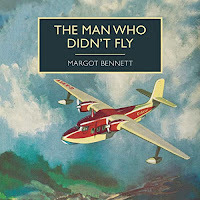 This is a beguiling mystery by Margot Bennett, first published in 1955 and recently republished in a nice new edition by the British Library, along with several other examples of Bennett's crime fiction. I listened to the audio version read by Seán Barrett and think it might have helped to have had the paperback to hand so I could flip easily back to clues and insight. I think I followed it to the end - but can see why other online reviewers found it a bit perplexing.
This is a beguiling mystery by Margot Bennett, first published in 1955 and recently republished in a nice new edition by the British Library, along with several other examples of Bennett's crime fiction. I listened to the audio version read by Seán Barrett and think it might have helped to have had the paperback to hand so I could flip easily back to clues and insight. I think I followed it to the end - but can see why other online reviewers found it a bit perplexing.Several commentators fix on what they see as a fundamental weakness but which I rather enjoyed - this isn't set up as a murder mystery. Instead, it begins with the loss at sea of a charter plane on its way to Ireland. Records show that a pilot and three passengers were aboard, but four men are known to have tickets. So who exactly is the man who didn't fly and why has he also disappeared?
That wheeze puts this novel in the same bracket as other mystery stories I've loved, such as The Franchise Affair by Josephine Tey (1948), or quite a few adventures of Sherlock Holmes, in not being a murder mystery. I can understand why some readers might find it a bit lightweight, insignificant. It's less Cluedo as Guess Who?
The police ask questions of people who encountered these various men in the days leading up to the fateful flight. That then leads to the bulk of the novel: an extended flashback over several days, all set in a wealthy family home. Two of the men seem romantically entangled with daughters of the house. At least one of the men is embroiled in something dodgy involved investments. None of it really seems to help us as readers play along in solving the puzzle.
But I found a lot of this stuff quite fun. It has the feel of a stage play, characters coming and going in the same drawing room, with conflicts and revelations coming thick and fast. Then two outsiders enter proceedings - a young burglar and an older man from Australia with a grudge. It began to look as if the three passengers on the plane might be drawn from a larger pool than the original four suspects.
(I also began to wonder if the continued reference to "the man" who didn't fly was setting up a twist where the missing person would turn out to be a woman who has switched places with one of the four.)
At last we return to the present to sift through everything we've had presented. The police methodically, logically, work through the evidence and - taking everything they've been told at face value - establish the identify of the fourth man. Then comes the brilliant twist that this does involve a murder mystery, the killing one aspect of wider criminal activity that there have been clues to all along.
But it's odd that this whole thing hinges on tragic chance - the plane crash being a random accident is another thing some readers criticise. The mild-mannered inquiry into who was involved has less dramatic urgency than a regular murder mystery. I liked it because it was something a bit different from the norm but can see why it would disappoint if you have a firmer sense of what mystery novels should be.
I've some more work by Bennett to get through, engaged in my own mild-mannered inquiry into what exactly she might have pitched in 1964 to Doctor Who. Martin Edwards' introduction to this novel has been helpful there - and his mention of Margot Bennett in Life of Crime sparked this thought in the first place. I've the first inklings of an idea about what she and story editor David Whitaker might have discussed but, like the dour police inspector in this novel, will hold off until I've gathered all the evidence.
January 4, 2024
Doctor Who Magazine #599
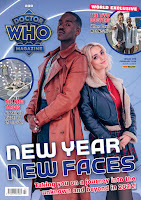 The new issue of Doctor Who Magazine is out today, with a deep dive by Benjamin Cook into the shooting of the regenerations sequence seen in The Giggle last year, and a new comic strip in which the TARDIS arrives in space Manchester. There's an interview with Millie Gibson who plays new companion Ruby Sunday, and chats with the teams behind the new TARDIS and sonic screwdriver.
The new issue of Doctor Who Magazine is out today, with a deep dive by Benjamin Cook into the shooting of the regenerations sequence seen in The Giggle last year, and a new comic strip in which the TARDIS arrives in space Manchester. There's an interview with Millie Gibson who plays new companion Ruby Sunday, and chats with the teams behind the new TARDIS and sonic screwdriver.On pages 42 and 43, there's my interview with post-production producer Ceres Doyle (who has worked on Doctor Who since 2004) and post-production supervisor Liv Duffin, who I spoke to in October.
There's also a nice review by Jamie Lenman of Whotopia, the book I worked on with Jonathan Morris and Una McCormack.
December 30, 2023
Adventures Across Space and Time - A Doctor Who Reader
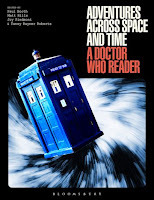 I've just received a copy of this collection of essays and insights on the cultural history and impact of Doctor Who, edited by Paul Booth, Matt Hills, Joy Piedmont and Tansy Rayner Roberts.
I've just received a copy of this collection of essays and insights on the cultural history and impact of Doctor Who, edited by Paul Booth, Matt Hills, Joy Piedmont and Tansy Rayner Roberts.I read a proof version in May and was asked if I'd provide an endorsement. My response then is now partially quoted on the back cover:
"A brilliant compendium of the brilliance of Doctor Who fandom. Intelligent, insightful and incredibly wide-ranging, this is a really engaging collection. I love the mix of new analysis and older pieces to give a comprehensive overview. A perfect introduction for those new to Doctor Who scholarship, and packed with interest for more established scholars. There's so much here I'd never even thought of. I finished it then immediately wanted to start reading again."
The book republishes some classic takes, with excerpts from The Making of Doctor Who (1972) by the series' then script editor Terrance Dicks and regular writer Malcolm Hulke, a 1973 letter to Radio Times by a teenage Peter Capaldi (later the Twelfth Doctor), and a 1995 post to rec.arts.doctor.who by Steven Moffat who was later executive producer of the series. There's a piece on 'canonicity' by my friend Paul Cornell, addressing his TV adaptation of Human Nature for the Tenth Doctor on TV when it was originally a novel featuring the Seventh Doctor.
There are excepts from cultural historians John Tulloch and Henry Jenkins, whose work I read closely while at university half a lifetime ago. This sits alongside an except from Pier Britton's authoritative book Design for Doctor Who, and a piece by Mary Robinette Kowal detailing the Doctor Who references hidden in her historical fantasy novels.
But what really thrilled me is the new essays original to this collection that cover an enormous range of ground. As I said in my endorsement, there's loads here that was new to this long-in-the-tooth hardcore fan. That was especially true of Magdalena Stonawska's piece on fandom in Poland, Eloy Vieira and Lilian FranÇa on fandom in Brazil and Ting Guo on fandom in China. There's stuff on fanzines and figurines and the financial cost (more than £300!) of following multimedia adventure Time Lord Victorious (of which I wrote one instalment). There's loads here to illuminate, inspire and challenge - and to argue with. What a delight.
(One slightly odd thing: I'm described on the back cover as "producer and author of How The Doctor Changed My Life (2008)", but I edited rather than authored that book, and it was quite a long time ago. I've done one or two other related things since.)
December 28, 2023
Garry Halliday and the Disappearing Diamonds, by Justin Blake
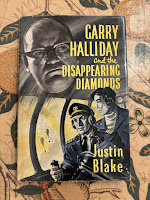 This is a concise, 125-page novelisation of the first Garry Halliday serial. The children's TV series about the adventures of an airline pilot ran for a total of 50 half-hour episodes, broadcast on Saturday evenings between 28 February 1959 and 29 September 1962; 11 episodes were then repeated between 5 November 1962 and 27 July 1963. For more than three years, Garry Halliday was a fixture in the schedule but it was then largely eclipsed by the series of serials that replaced it in the same Saturday teatime slot: Doctor Who.
This is a concise, 125-page novelisation of the first Garry Halliday serial. The children's TV series about the adventures of an airline pilot ran for a total of 50 half-hour episodes, broadcast on Saturday evenings between 28 February 1959 and 29 September 1962; 11 episodes were then repeated between 5 November 1962 and 27 July 1963. For more than three years, Garry Halliday was a fixture in the schedule but it was then largely eclipsed by the series of serials that replaced it in the same Saturday teatime slot: Doctor Who.While I was researching the life of David Whitaker - who worked on two Garry Halliday serials before becoming first story editor of Doctor Who - I read some contradictory stuff about the earlier series. Despite what you may read elsewhere, it was not adapted from books by Justin Blake; instead, the five books published 1960-65 were novelisations of broadcast TV serials. Nor did the TV series comprise a single 'trailer' episode and then two serials of 16 and 33 episodes respectively; there were seven serials of either six or seven episodes, and then an eighth series of six one-off episodes.
Such misconceptions are common when discussing old TV that no longer exists (only one episode of Garry Halliday survives in the archive), based on decades-old memories. The novelisation is a record of what has been lost, its six chapters providing a useful precis of the six broadcast episodes, with details of plot, pace and tone, and even descriptions of some of the sets. It can also help correct other misconceptions.
For example, the villain of the series is known as The Voice because even his own hench-people never see him in person. Some sources say that in the first serial The Voice disguised himself by shining a powerful light in the faces of those who report to him. The novelisation makes clear he works from an office with a two-way mirror and his minions are only admitted to the so-called Mirror Room. It may be that the light shone in people's faces is from a later serial, or it may be that what a viewer remembers is the way the Mirror Room scenes were shot, with close-ups of anxious hench-people.
What's more, Halliday is here a pilot for the British Overseas Airways - surely a little too close to the real-life British Overseas Airways Corporation (1939-74). It's only after this first adventure that he sets up his own airline, Halliday Charter Company.
So, the plot. On several flights back from Amsterdam, keen-eyed Halliday (Terence Longdon) spots an unexpected sight: what look like weather balloons but smaller. Halliday's co-pilot Bill Dodds (Terence Alexander, later Charlie Hungerford in Bergerac) - who narrates the novelisation - and stewardess Jean Wills (credited in Radio Times as Ann Gudrun, but better known as Gudrun Ure aka Supergran) fail to spot the balloons, and the authorities don't believe him either.
When Dodds tells a friend in the pub about this, they are overheard by a trainee steward called George Bassett (Geoffrey Hibbert), who then reports this conversation to The Voice. It turns out that Halliday has stumbled on to a diamond-smuggling operation. On his next flight, Halliday diverts course so that Dodds and Wills finally see a balloon but Bassett convinces them not to report this without better evidence; they agree to bring a cine camera with them on their next flight.
But as that flight takes off, Bassett has planted a bomb among the luggage...
In the second episode / chapter, Halliday learns of the bomb and disposes of it in the nick of time. In Amsterdam, he and his friends then investigate where the balloons have been launched from. They deduce it must be somewhere near the coast and drive around asking local people what they might have seen. This leads them to a windmill, where they are apprehended by two gunmen...
And so it goes on, Halliday surviving a series of scrapes. The obvious comparison is to the adventures of Biggles, though it reminded me a lot of John Buchan's Hannay stories. The diamond-smuggling plot may owe something to James Bond - the first Bond film wasn't out until 1962, but the novel Diamonds are Forever was published in 1956 and Ian Fleming's non-fiction book The Diamond Smugglers the following year. To expose the villains, Bond pretends to be a diamond-smuggler called Peter Franks; Halliday also pretends to be a diamond smuggler, but is really working on behalf of police inspector Franks. (The film version of Diamonds are Forever (1971) features stuff set in Amsterdam but the original novel does not.)
Just as with the adventures of Bond and Hannay, some elements mentioned in passing are a shock to the modern reader. The most glaring example is the racist joke when Dodds and his friends are in the cockpit scanning the air for balloons,
"and looking like a lot of daft coons watching a whole in the road or something" (pp. 20-21)
This comes from Dodds, who is a otherwise presented as a well-meaning bungler - we're told on the first page that his nickname is "Hopeless". He's largely there for comic relief; there's a fun sequence when he tries to pretend that the fugitive Halliday is not hiding in his house, and a more suspenseful bit towards the end of the story when, not privy to what's really going on and only trying to help, he leads the police to the wrong house, leaving Halliday in a fix with the enemy. In fact, there are some very effective moments of suspense and some genuine threat, such as the prospect of a whole plane-load of innocent people being murdered just to cover The Voice's tracks. I can see why the series hooked viewers.
The cover of the book may also tell us something about the popular appeal of the series. The artwork is by Lee Kenyon, based - we're told in the inside flap - on photographs supplied by the BBC. The top half of the cover is dominated by a close-up portrait of Elwyn Brook-Jones as The Voice, moodily lit and photo-realistic. Beneath him, in medium shot, is a more comic-strip portrayal of Halliday and Dodds in the cockpit, neither a particularly good likeness of the actors and Dodds looking off to one side at two balloons in the sky. The emphasis is surely on the villain, suggesting that he was the chief appeal.
I'm also struck by how little Jean Wills has to do, for all she insists on not being left out of things. She may have had more dialogue in the TV version but says very little in the book, and the only other female character is the unseen airport announcer. We can compare that to the first year of Doctor Who where Susan Foreman and Barbara Wright have so much to say and do, alongside a number of notable female guest characters.
It's also odd to read a story made for children that includes a visit to the pub and people smoking, or that includes the discomforts of a strip search. Oddest of all given that this is narrated by a co-pilot is the lack of any details about flying a plane, what's involved in navigation or changing course, or even the protocols of communication with the ground. The nearest we get is on page 68 when Halliday spells his name out in a joke-version of the NATO phonetic alphabet.
"Garry said: 'H for Holland. A for Amsterdam. L for Latitude. Another L for Longitude. I for Interesting. D for Diamonds. A for Altitude. Y for Yours Truly.'"
But while Dodds tells us a little about his own past - service in the RAF, where he was teased for being "Hopeless" - we get very little sense of Garry Halliday as a person, beyond his dogged determination and usefulness in a fight. Perhaps most revealing is when Dodds lists the contents of Halliday's overnight bag:
"Pyjamas, a couple of handkerchiefs, spare socks, a tie, slippers, a flashy silk dressing-gown one of his girls gave him for Christmas, a Penguin book by Raymond Chandler and another by Jane Austen, sponge-bag with toothpaste, toothbrush, razor and shaving soap." (p. 90)
This determined adventure hero reads Austen but doesn't pack a change of underpants. And does "one of his girls" mean he's a womaniser or a dad? We're not told - because the series entitled Garry Halliday isn't really about him.
December 27, 2023
Titanium Noir, by Nick Harkaway
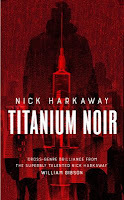 The idea of mashing up detective fiction and sci-fi isn't new. Isaac Asimov did it in The Caves of Steel and The Naked Sun in the 1950s (the latter of which I reread last month). As a kid, I was a big fan of Robo-Hunter in 2000AD, in which hero Sam Spade is a space-travelling version of Dashiell Hammett's Sam Spade.
The idea of mashing up detective fiction and sci-fi isn't new. Isaac Asimov did it in The Caves of Steel and The Naked Sun in the 1950s (the latter of which I reread last month). As a kid, I was a big fan of Robo-Hunter in 2000AD, in which hero Sam Spade is a space-travelling version of Dashiell Hammett's Sam Spade.As I've argued before, I think science-fiction and the detective story share a lot in common anyway, not least in the way we read them. We follow a plot but we're also looking for clues - in the detective story to work out whodunnit, in sci-fi to understand how this world operates differently from our own. We also read (and write) such stories with a knowledge of what's gone before in the genre, so judge each new work on its ability to follow conventions while both avoiding cliche and adding something new.
Titanium Noir is much closer to a Dashiell Hammett style thriller, with narrator Cal Sounder a world weary, wise-cracking gumshoe acting as a buffer between the police and super-rich elite called "Titans" in a gritty near-future. When one of the Titans is found dead, apparently having shot himself, Cal can look into things on a softer, less formal basis than the police, but also without the protection that goes with carrying a badge.
What makes this world different from our own is that the super-rich can afford injections of Titanium 7. As we're told early on,
"It's a rejuvenation treatment given by infusion. It turns the body's clack back to pre-puberty, then runs you through it at speed. It's also used to stimulate regeneration of severely damaged organs and limbs. It really does make you young again, but since it starts with an adult body, it also makes you bigger, hence the name [Titans]. Oh, and it's so expensive almost no one has it. Strictly for the speciation rich." (pp. 10-11)
There's obviously something in this akin to IVF which also jump-starts the body like putting it through puberty again. As with IVF, the result is painful and takes months to recover from. But Titans then live extremely long lives.
There's a stark division between the Titans who've received T7 and the mass of ordinary, little people who haven't. We see the impact of this on one particular relationship where one party is a Titan. But there's more nuance here than a simple divide between haves and have-nots. Over decades, some Titans have had more than one infusion - each one making them bigger, stranger, something else. There are gradations of Titan, separate from one another, and also families and attachments and conflicts between different groups.
Newly created Titans are also strong and horny, so specialist establishments cater for titanic sex, while the media revels in gossip (and recordings of) the ins and outs of who is doing what to who. Many ordinary people are keen to get in on the action, and to modify themselves to look more like Titans while unable to afford T7. From this one medical intervention has developed a whole culture.
This all makes for a richly drawn environment in which the plot neatly twists and turns. The novel rattles along, zigging and zagging with everyone under suspicion - even the narrator, whose loyalties we're not always sure of. The final reveal of the killer hinges on something we've been told early on - a nicely played clue that seems obvious in retrospect but took this reader by surprise. And it's all wrapped up in 236 pages - a quick, exciting and satisfying read.
Dashiell Hammett used Sam Spade in several stories, and also created other heroes who featured in multiple adventures (ie the Continental Op, Nick and Nora Charles and secret agent X-9). It would be fun to see Cal Sounder in further adventures, exploring more of this world - and Sounder's changed position within it given what happens in this book. But that will have to wait, as first Nick Harkaway is writing a George Smiley novel.
See also:
Me on Silverview by John le Carre (and completed by Nick Harkaway)Me on The Thin Man by Dashiell HammettDecember 20, 2023
Vworp Vworp! #6
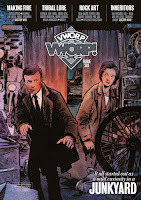 The latest issue of ginormous Doctor Who fanzine Vworp Vworp! is now available, with 180 glossy pages devoted to the very first episode, An Unearthly Child, plus a DVD with added wonders.
The latest issue of ginormous Doctor Who fanzine Vworp Vworp! is now available, with 180 glossy pages devoted to the very first episode, An Unearthly Child, plus a DVD with added wonders.My piece, "David the Goliath" (pp. 23-25) is on the thesis that without David Whitaker as story editor, Doctor Who would never have survived it's first year. I endeavoured to be objective in my biography; here, I was asked to let rip.
The DVD includes an animated version of "A Meeting on the Common", the first chapter of David's 1964 novelisation Doctor Who in an Exciting Adventure with the Daleks, itself adapted from the TV serial that comprises Doctor Who episodes 5-11. The animation, effectively a new opening for all of Doctor Who, is directed and animated by Mel Meanley, adapted by Ian Winterton and stars Stephen Noonan as the Doctor, Adam Grayson as Ian, Helen Stirling-Lane as Barbara and Kerry Ely as Susan. Here's the trailer:
In my book, I discuss why this meeting takes place on Barnes Common and the elements of David Whitaker's real life that fed into it. In fact, the new animation is not the first dramatised version of this material, as I learned from The John Nathan-Turner Production Diary 1979-1990 by Richard Molesworth (Telos, 2022). Richard was then kind enough to let me have sight of the original paperwork.
In the summer of 1981, Philip Lewis - a BBC employee based in Room 4, 16 LS at Broadcasting House in London - wrote to Doctor Who producer John Nathan Turner about a script he (Lewis) had written for 'Episode 1' of Doctor Who and the Daleks, adapting the early chapters of David Whitaker's novelisation as an audio play. Lewis wanted the producer's permission to allow the Studio Amateur Dramatic Group (SADG) of the BBC Club to record this, on the proviso that it would be made by and played for club members only, and was not intended for broadcast. The idea was to use it as an exercise in adapting a novel for radio. Lewis assured the producer that the Daleks didn't feature - i.e. the episode concluded before they made their first appearance.
Replying on 4 June, Nathan Turner agreed in principle that this project could go ahead but wanted to check with Martin Hussey, merchandising assistant at BBC Enterprises, whether the project needed the blessing of Roger Hancock, agent of Dalek creator Terry Nation. The producer forwarded Hussey the script the following day; a copy of his covering memo survives. There's no record of a reply and the script doesn't seem to have been returned, so is not included in the Nathan Turner archive.
Staff at the BBC's Written Archive Centre were unable to locate a copy of the script or any further details about this production. No recording, cast list or other paperwork is known to survive. I've also drawn a blank in trying to trace Philip Lewis; he's surely not the man of the same name who was a long-serving TV producer for BBC Midlands and created Pot Black.
But if SADG recorded a version of the script by Lewis, it may well have been technically accomplished. SADG helped BBC staff learn key skills in production. For example, Bob Wood was a senior clerk working in the current recordings retention unit at Broadcasting House in the 1960s, but joined this (and other) groups:
"At SADG, I learnt to be a radio studio manager and producer, eventually becoming their technical training officer and winning a technical trophy ... In 1970, after successfully completing the POA/SM training course, I left London and moved to Glasgow as a radio studio manager at BBC Scotland." (Bob Wood, "BBC hostels & the summer of love", Prospero issue 6 (December 2018), p. 8.
If anyone can add further light on this, do please get in touch.
December 18, 2023
Connections with James Burke
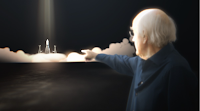 I've really enjoyed this new six-part series on Curiosity Steam, with my hero James Burke returning to the subject of the unexpected history of change. There are two big differences between this and the 1978 series Connections that Burke made for the BBC, which I blogged about a decade ago. (Since then, it's been released on DVD by Simply Media in 2017 and is, er, currently all on YouTube).
I've really enjoyed this new six-part series on Curiosity Steam, with my hero James Burke returning to the subject of the unexpected history of change. There are two big differences between this and the 1978 series Connections that Burke made for the BBC, which I blogged about a decade ago. (Since then, it's been released on DVD by Simply Media in 2017 and is, er, currently all on YouTube).First, that original series had - like lots of the BBC's science documentaries then and now - a lot of Burke out in the field, striding through picturesque locations to illustrate his thesis. Here, things are on a smaller, less expensive scale with the older Burke on a virtual set, his arguments illustrated by what looks like stock footage and bits of CGI swirling around him. At some points they use CGI to animate him - he even dances (!) - and there are also some props, such as when he dons the Macktinosh waterproof coat he's telling us about. But the effect of all this is to underline that these are basically lectures. It's all more TED talk than Brian Cox out on a mountain pointing at stars.
Nowhere is this more starkly evident than in Episode 5, where Burke discusses the usefulness of the vacuum flask. He makes his case then turns and points behind him, as in the screenshot above. We get a CGI animation of a rocket blasting off - a fun gag and call-back. In the original, out on location and perfectly timed to the launch of the Titan-Centaur rocket carrying Voyager 2 in space, it creates an iconic bit of TV:
(Burke's old programmes are full of extraordinary, ballsy stuff like this. He explains gravity while sat on a roller-coaster, and hands the Apollo astronauts a plastic bag they all recognise and asks them to explain how this was used as a toilet in space.)
Secondly, each episode in the new Connections begins with a change that hasn't happened yet: a prediction of the near future. The old BBC series used connections to explain how we got to be where we are; this new series is about where we're going.
To give a sense of the format, Episode 1, Seeing the Future, begins with Burke talking about the potential of quantum computing to crunch such vast sets of data that it will be able to predict the future to a high degree of accuracy. We then duck back in time to 1814 and the Emperor Napoleon Bonaparte's toothpick. Animation in a style slightly reminiscent of Monty Python shows Napoleon escaping from Elba.
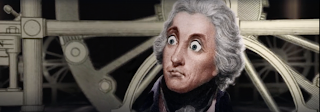 An example of the animation from
An example of the animation fromConnections with James Burke
The fun is in seeing how Burke will get from this toothpick to quantum computing in a series of logical steps. Those steps are often surprising because of unintended consequences of a given change or new invention. Sometimes it's a less direct connection. For example, Napoleon's toothpick was supplied by George Bullock, and Bullock's brother William didn't just ship stuff out from the UK but also brought stuff home, organising exhibitions of exotic stuff in "living museums". To ship such stuff from far-off locales, Nathaniel Bagshaw Ward perfected the "Wardian case", which meant plants survived long journeys. That, in turn, meant Robert Fortune could smuggle tea plants out of China and help set-up tea plantations in India, with a profound impact on trade.
We're then on to the ships used to carry these good quickly - the clippers using sail and then the iron ships powered by steam. Then we're onto the same ships carrying palm oil, and it's use in soap, and the way that was packaged and branded... On and on it goes, a hop-scotch through time, with regular recaps of the connections so far.
Episode 2, The End of Scarcity, predicts the universal replicator by following the chain from Louis XIV's wig.
Episode 3, In the Net, predicts humans merging with the internet and Episode 4, None of This is Real, predicts avatars that are indistinguishable from humans, with AI as the gatekeeper to knowledge - the latter reached by following a chain from shipworm.
Episode 5, Designer Genes, gets to the titular editing of who we are from coffee beans in Leipzig, and the final episode, Limitless Energy, predicts energy autonomy based on perovskite solar cells leading to a post-scarcity society with no need for climate change or war - all from the starting point of a potato.
Burke is an engaging and often funny speaker, with just the right tone of irreverence for these leaps of imagination. For example:
"In 1852, one of [William Bird] Herapath's students notices, as you would, that if you add iodine to dog's urine, if the dog has already been fed quinine - okay, okay, but this is what geeks do - then you get needle like crystals." (None of This is Real)
These crystals polarise glass, leading to the invention of both polarised glasses and the polaroid camera.
But there's plenty of serious stuff behind these arguments. A key theme is the way science can open up opportunities and provide benefits for all. In discussing the steps that lead to designer genes, he notes that two brilliant women responsible for key connections along the way, both died while young. Given that the end point is about improving health, he asks what Ada Lovelace and Rosalind Franklin might have gone on to contribute if they'd lived longer.
That, I think, is another key difference from the original series, which I felt assumed a male viewer, Burke speaking to his peers. This is all much more inclusive and I don't think Burke is now talking to his own generation. Instead, he addresses those who will follow, encouraging them to take part in the bright future he sees ahead. That's what really strikes me about this series: it's optimism for where we go next.
See also:
Interview with Burke about the new series by Jennifer Ouellette for Art TechnicaMe on The Pinball Effect by James BurkeMe on Doctor Mirabilis by James Blish (1964), my reading informed by watching Burke's 1985 series, The Day The Universe ChangedDecember 17, 2023
Our Mutual Friend, by Charles Dickens
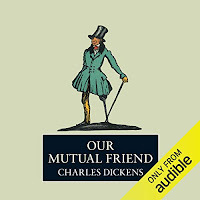 Over a series of long drives and shorter washings-up, I've worked my way through this 35+ hour reading of Our Mutual Friend, the novel by Charles Dickens first published in 1864-65, and the last novel he completed. The audiobook version was brilliantly read by David Troughton.
Over a series of long drives and shorter washings-up, I've worked my way through this 35+ hour reading of Our Mutual Friend, the novel by Charles Dickens first published in 1864-65, and the last novel he completed. The audiobook version was brilliantly read by David Troughton.Lizzie Hexam is scared of the Thames but dutifully joins her father in his boat to scour the water for valuable jetsam. One night her father finds the body of a dead young man, identified as John Harmon. Harmon is the heir to a fortune, conditional on his marrying a Miss Bella Wilfer - who he has never met. With Harmon dead, the fortune passes to an eccentric but kindly couple, the Boffins. And they feel they ought to do something by Miss Wilfer, so take her in as their own. But Bella, the Boffins and lots of people around them are affected by this new-found wealth, and not always for the better. The Boffins have also taken on a secretary, John Rokesmith, who has a mysterious past...
I first read this novel in 1998 having loved the BBC TV adaptation starring Keeley Hawes as Lizzie Hexam and Paul McGann as the aesthete Eugene Wrayburn who falls for her, Anna Friel as Bella Wilfer and Steven Mackintosh as John Rokesmith. The thing that struck me then was the book's attention to water - the river Thames, the locks and canals, the connections afforded by its flow.
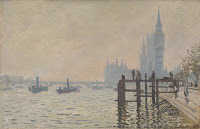 In part, I think that chimed with me because of other depictions of the Thames from the same period - namely by the Impressionists, which I studied at A-level. Here's "The Thames below Westminster" by Claude Monet, painted 1870-71, and now in the collection of the National Gallery. I had this sense of Dickens producing a similarly vivid, dashed-off impression of the river in prose.
In part, I think that chimed with me because of other depictions of the Thames from the same period - namely by the Impressionists, which I studied at A-level. Here's "The Thames below Westminster" by Claude Monet, painted 1870-71, and now in the collection of the National Gallery. I had this sense of Dickens producing a similarly vivid, dashed-off impression of the river in prose.Except that's not what he did at all, as I learned in 2015 from "Charles Dickens and Science", a talk given at Gresham College by Lord Hunt of Chesterton, for which the video and full transcript are still available. It turns out that engineer John Scott Russell, who identified in his designs for ships that waves have an associated force, worked for Dickens as the railways editor at the Daily News and provided the technical detail in Our Mutual Friend, where the behaviour of the water of the Thames articulates the science of fluid dynamics decades ahead of its time.
Rereading the novel now, what struck me most was the number of subterfuges involved. Rokesmith and the Boffins deceive Miss Wilfer. Though they claim this is for her best interests, and things all work out in the end, I can't imagine anyone would really accept such deception so readily. Yet Miss Wilfer is also involved in deception: she gets married without telling her busy-body mother and sister, while her father has to pretend he wasn't at the ceremony.
These are all good people lying for good reasons but there are deceptive villains, too. The Lammies marry thinking that one another is rich; when they realise they have no money between them, they must continue to hide the truth from everyone else. Roger Riderhood and Bradley Headstone both attempt to leave false trails to incriminate others. Then there are characters who deceive themselves: Headstone over Lizzie's affections, Silas Webb over his rights to the Boffins' fortune.
At the heart of all this is the difference between the 'mask' we present to other people and society as a whole, and the importance of being true to ourselves and our loved ones. And yet that truth is not the same thing as honesty. A lie is okay, even virtuous, when it is meant to aid someone else. The morality here isn't simple black and white, one thing or the other. The dynamics are more fluid.
See also:
My review of Dickens by Claire TomalinMy talk for the National Portrait Gallery - Doctor Who: Portraits in Time and Space (including Charles Dickens)Me on Conan Doyle's The Sign of Four, including stuff on the ThamesMy review for the Lancet Psychiatry of the Dickens Museum's temporary exhibition, Charles Dickens: Man of Science.December 16, 2023
A Gentleman in Moscow, by Amor Towles
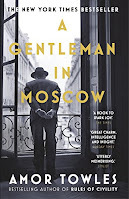 On 21 June 1922, Count Alexander Ilyich Rostov is called before the Emergency Committee of the People's Commissariat for Internal Affairs in Moscow. He's identified as the author of Where Is It Now?, a poem published in 1913 and considered by some to be a call to action after the failed revolt of 1905. But despite these credentials, the count is also an aristocrat, was out of the country during the revolutions of 1917 and is deemed to have "succumbed irrevocably to the corruptions of his class" (p. 5). He is placed under house arrest in the Hotel Metropol and remains there for years...
On 21 June 1922, Count Alexander Ilyich Rostov is called before the Emergency Committee of the People's Commissariat for Internal Affairs in Moscow. He's identified as the author of Where Is It Now?, a poem published in 1913 and considered by some to be a call to action after the failed revolt of 1905. But despite these credentials, the count is also an aristocrat, was out of the country during the revolutions of 1917 and is deemed to have "succumbed irrevocably to the corruptions of his class" (p. 5). He is placed under house arrest in the Hotel Metropol and remains there for years...But he does more than just survive; he flourishes.
This is an extraordinary, bewitching novel - a man out of his time in a fast-changing new order, his old-world values at odds with the officiousness of modernity. Rostov is a charming, suave protagonist, able to assist and advise a broad range of those he encounters in the hotel, building up friendships and even a family. It's a story of one man against the odds like so much thrilling spy fiction - and there's a feeling of le Carre throughout, which I mean as high compliment. (Rostov likens himself more to Sam Spade in the film version of The Maltese Falcon).
Yet what really makes this work is that it's often so playful and fun. The reader is just another in the line to fall for Rostov's charm. And then, in the last section, there's a direct threat to Rostov and someone he holds very dear, and it all gets much more suspenseful, to the very last page.
A Gentleman in Moscow was the last novel my late father finishing reading - while in hospital for almost the last time - and the last book he recommended to me. Reading it has been a little like a conversation with him, not least because I can see why he'd have liked it so much. There's something of my dad in Rostov, and his wit and worldview. For all this novel enthralled me, it's taken a while to finish, in part because I've been busy on other things. But now, on completing it, I realise I lingered - a book, and connection, I didn't want to put down.
November 29, 2023
Happy Times and Places - An Unearthly Child
 To mark 60 years of Doctor Who, Toby Hadoke has devoted a special five-part instalment of his Happy Times and Places podcast to the very first episode, An Unearthly Child. I'm in part four.
To mark 60 years of Doctor Who, Toby Hadoke has devoted a special five-part instalment of his Happy Times and Places podcast to the very first episode, An Unearthly Child. I'm in part four.Toby asked a bunch of us to watch the episode then nominate our five favourite things about it, which he then responds to. I won't spoil who else is involved but there are some brilliant insights, underlining my point that there's always being something new to be discovered.
Also by me on this blog:
An Unearthly Child takes place on a TuesdayWhat the first Doctor Who serial owes to The Inheritors by William GoldingDoctor Who: 1963Simon Guerrier's Blog
- Simon Guerrier's profile
- 60 followers



